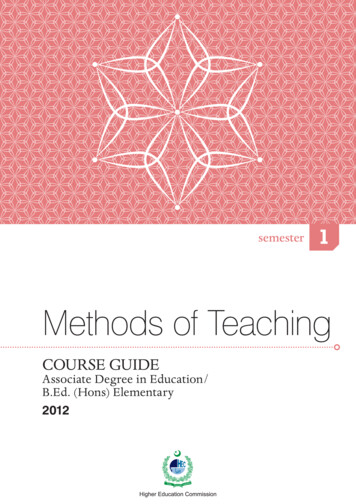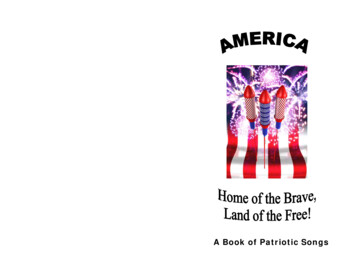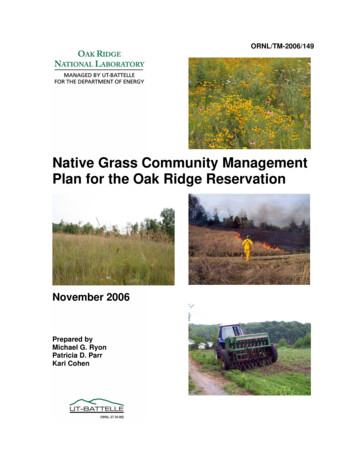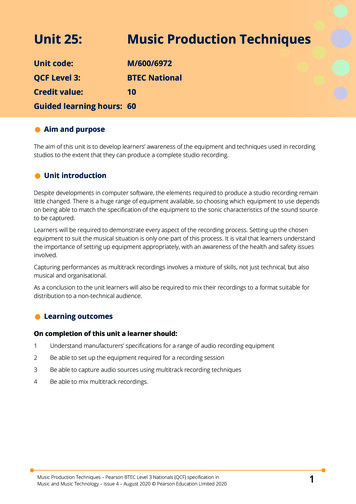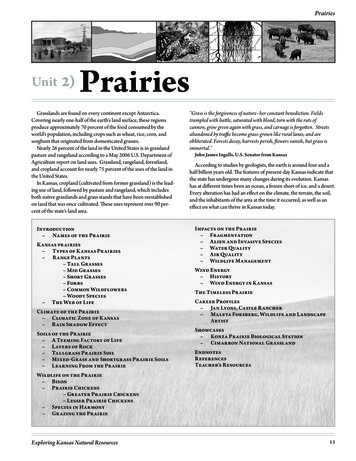
Transcription
PrairiesUnit2) PrairiesGrasslands are found on every continent except Antarctica.Covering nearly one-half of the earth's land surface, these regionsproduce approximately 70 percent of the food consumed by theworld's population, including crops such as wheat, rice, corn, andsorghum that originated from domesticated grasses.Nearly 26 percent of the land in the United States is in grasslandpasture and rangeland according to a May 2006 U.S. Department ofAgriculture report on land uses. Grassland, rangeland, forestland,and cropland account for nearly 75 percent of the uses of the land inthe United States.In Kansas, cropland (cultivated from former grassland) is the leading use of land, followed by pasture and rangeland, which includesboth native grasslands and grass stands that have been reestablishedon land that was once cultivated. These uses represent over 90 percent of the state's land area.Introduction– Names of the PrairieKansas prairies– Types of Kansas Prairies– Range Plants– Tall Grasses– Mid Grasses– Short Grasses– Forbs– Common Wildflowers– Woody Species– The Web of LifeClimate of the Prairie– Climatic Zone of Kansas– Rain Shadow EffectSoils of the Prairie– A Teeming Factory of Life– Layers of Rock– Tallgrass Prairie Soil– Mixed-Grass and Shortgrass Prairie Soils– Learning From the Prairie“Grass is the forgiveness of nature–her constant benediction. Fieldstrampled with battle, saturated with blood, torn with the ruts ofcannon, grow green again with grass, and carnage is forgotten. Streetsabandoned by traffic become grass-grown like rural lanes, and areobliterated. Forests decay, harvests perish, flowers vanish, but grass isimmortal.”John James Ingalls, U.S. Senator from KansasAccording to studies by geologists, the earth is around four and ahalf billion years old. The features of present-day Kansas indicate thatthe state has undergone many changes during its evolution. Kansashas at different times been an ocean, a frozen sheet of ice, and a desert.Every alteration has had an effect on the climate, the terrain, the soil,and the inhabitants of the area at the time it occurred, as well as aneffect on what can thrive in Kansas today.Impacts on the Prairie– Fragmentation– Alien and Invasive Species– Water Quality– Air Quality– Wildlife ManagementWind Energy– History– Wind Energy in KansasThe Timeless PrairieCareer Profiles– Jan Lyons, Cattle Rancher– Maleta Forsberg, Wildlife and LandscapeArtistShowcases– Konza Prairie Biological Station– Cimarron National GrasslandEndnotesReferencesTeacher's ResourcesWildlife on the Prairie– Bison– Prairie Chickens– Greater Prairie Chickens– Lesser Prairie Chickens– Species in Harmony– Grazing the PrairieExploring Kansas Natural Resources13
PrairiesOne part of Kansas thatlooks now much like it hasfor the last ten thousand yearsis the prairie. During theCenozoic Era (sometime inthe last 63 million years), afterglaciers smoothed the landinto plains and the water runGreenwood Countyoff created rivers and streams,Credit: John Charlton, KGSthe deep-rooted grass utilizedthe exposed soil and set down roots. As it matured and ripened, theprairie grass gradually expanded its territory, mostly by the windwhich carried seeds further to new soils. In a new spot, the grass usually adjusted its needs as best possible to the environment, includingsoil type and the amount of water present. This created a constant ifalways changing appearance.By the time the first humans roamed the central part of NorthAmerica, the grasslands were solidly established. The North American prairie was called an inland sea, both for the resemblance itsgrasses made to ocean waves as the stalks swayed in the wind, andbecause it reached farther than the eye could see.Surface Area of Kansas – Prairies(Pastureland & Rangeland)Pastureland& Rangeland18,242,200 acresTotal Surface Area 52,660,800acresForest LandOther Rural LandDeveloped LandCropland*Federal LandWater Areas*Cultivated and non-cultivated croplandas well as land enrolled in the ConservationReserve Program (CRP)Source: 2003 Natural Resources Inventory, USDA NRCSNames of the PrairieFrench explorers and fur traders in the 1700s have been creditedwith first calling the middle section of America “la prairie,” the Frenchword for meadow. The prairie goes by many names.Rangeland– Land on which the native vegetation is predominantlyFlint HillsCredit: Megan BlytheThe Great PlainsThe Great Plains is a major ecological region found inthe central part of the continent ofNorth America, occupying nearly 1.4million square miles. This area extendsfrom the Canadian provinces of Alberta,Saskatchewan and Manitoba south intonortheastern Mexico and from westernIndiana to the foothills of the RockyMountains. Approximately 34 million peoplelive in the Great Plains, including 32 million inthe U.S. portion of the region.grasses, grass-like plants, forbs, or shrubs. It includes desert, tundra,and forested rangeland. Rangeland is most suitable for grazing. Thereare limiting factors prohibiting cropland agriculture such as rocks,trees, or mountains. Surprising to some, rangeland biomes requirehuman and fossil energy to manage and maintain the grassland formany uses. Without proper management, the prairie moves towarda woody vegetation type. Approximately 47 percent of the earth’sterrain is rangeland.Grassland– Grassland is a generic term referring to an area coveredwith vegetation types dominated by grasses. It can include tamepasture, rangeland, and other types.Pasture– A unit of grassland which has a fenced perimeter. A mod-ern term that needed definition only after humans began to containlivestock. Often, biologists consider pasture to be made of one or onlya few types of grass versus an area containing a wide variety of plantlife like the native grass prairie.Across the Great Plains, rainfall decreases from east to west–definingdifferent types of native prairies. While there are grassland and forestcombinations along the eastern edges of the Great Plains, few nativetrees occur across other areas of the region. The Great Plains is one ofthe largest farming and ranching regions of the world and agricultureis the most important economic activity of the Great Plains.The entire state of Kansas falls within the Great Plains ecologicalregion. However, in Kansas, many people refer to the western twothirds of the state as the "Great Plains."Source: EPARangelandCredit: Doug Wilson, USDA ARS14Kansas Foundation for Agriculture in the Classroom
PrairiesKansas Prairie RegionsTame Pasture– land intentionally planted for grazing, usually seeded toperennial grasses or legumes, such as clover or timothy.MixedGrassKansas Prairies"We say of the oak, 'How grand of girth!'Of the willow we say, 'How slender!'And yet to the soft grass clothing the earthHow slight is the praise we render."ShortGrassTallGrassEdgar Fawcett, American-English novelist and poetCredit: Travis W. Taggart, Kansas Herpetofaunal Atlas, Sternberg Museum of Natural HistoryTypes of Kansas PrairiesThe Kansas grassland biome is divided into tallgrass, mixed-grass,and shortgrass prairies. Areas of sand prairie and sandsage prairiegrasslands are found in both the mixed-grass and shortgrass prairieregions of Kansas.Tallgrass prairie–Before settlement, thetallgrass prairie occupied anorth-south strip which encompassed the eastern thirdof Kansas. The tallgrass prairieexists today since much ofthe land is not tillable due toTallgrass Prairieterrain, (slope, rock layers,Credit: Erwin W. Cole, USDAsoil depth, etc.). The grassescan grow in excess of six feet tall during moist years if they reside indeep soils. The annual precipitation in this region exceeds 30 inches.The original tallgrass prairie spanned almost 250 million acres. Today,about four percent remains with the largest areas being the Flint Hillsof Kansas and the Osage Hills of Oklahoma.Mixed-grass prairie–The mixed-grass or midgrassprairie runs through themiddle portion of the state.The grasses here often growto be two and three feet tall.Typically, this region receives15 to 25 inches of precipitation per year. The primaryfactors which create mixedgrass prairie in Kansas areprecipitation and soil depth.Mixed-grass Prairie atKanopolis State ParkCredit: Wayne StoskopfShortgrass prairie– The shortgrassprairie lies mainly in the western portion of the middle United States, eastof the Rocky Mountains. The grasseshere are usually less than two feettall. The westernmost areas receive, atmaximum, 15 inches of precipitationper year.Shortgrass Prairie in Cheyenne CountySand and Sandsage Prairies in KansasTypical sand dunes in Kansas are 20-40 feet high, although they canexceed 80 feet in height. Smaller sand dunes give the landscape a gently rolling appearance while large sand dunes rise as mounds or smallhills. Sand dunes are characteristic of two grassland types in Kansas:the sand prairie and the sandsage prairie.In Kansas, areas of sand prairie are found in the Arkansas River Lowlands, the Red Hills, the Smoky Hills, and the Wellington-McPherson Lowlands. The largest area of sand prairie in Kansas is the GreatBend Sand Prairie, which lies south of the bend in the Arkansas Riverand covers 1,100 square miles in Barton, Stafford, Edwards, Kiowa,Pratt, Reno, and Rice counties. According to the Kansas GeologicalSurvey, sometime in the last 1,000 years, northwesterly winds probably blew sand out of the Arkansas River and deposited it on nearbylands to form the Great Bend Sand Prairie.The primary plant species found in the sand prairie is sand bluestem.Other species found in these areas include prairie sand reed, prairiesunflower, beebalm, fourpoint evening primrose, switchgrass, sandhill plum, and little bluestem.Tracts of sand prairie in Kansas include Sand Hills State Park inReno County and Pratt Sandhills Wildlife Area in Pratt County,both owned and managed by the Kansas Department of Wildlife andParks. Bethel College owns and manages the Sand Prairie NaturalHistory Preserve in Harvey County. Interstate 70 crosses a smallarea of privately-owned sand prairie in Dickinson County.Sandsage prairie is found in southwestern Kansas, mostly west ofUS Highway 183 and south of the Arkansas and Cimarron rivers.Small areas of sandsage prairie are also found in the Red Hills. Theconspicuous plant species of the sandsage prairie is sand sagebrush,an aromatic shrub with many gray-green branches that grows up tofour feet tall. The lesser prairie chicken is a sandsage prairie resident.Areas of sandsage prairie in Kansas include the Cimarron NationalGrassland in Morton County and the Sandsage Bison Refuge andWildlife Area in FinneyCounty, which is home to thestate's oldest publicly ownedbison herd. Privately-ownedareas of sandsage prairie canbe seen along Kansas Highway 25 in southern HamiltonCounty and Kansas Highway 27 in southern KearnyCounty.Kearny County Sand PrairieCredit: John Charlton, KGSCredit: NRCS, St. Francis, KSExploring Kansas Natural Resources15
PrairiesBurning the PrairieOne practice unique to the tallgrass prairie is the prescribed burningof the native prairie in spring. Periodic fires have played a role in thehistory of the prairie grasslands. Lightning strikes were probably thefirst sources of fire on the prairie. What might have seemed devastating at first proved to have great benefits. Within weeks of a fire, agreen carpet of fresh grass would surface from the blackened hills.The American Indians saw the effects of the burning and set theirown fires to attract the roaming bison to the rich grass closer to theIndians’ home territories, making for easier hunting that summer.After settlement of the prairies occurred, more fires were from accidental human causes, and could be devastating, but their positiveeffects on the grassland were the same.Fire removes standing dead vegetation and light mulch, allowingsunlight to warm the soil and encourage rapid plant growth. Withoutrecurring fires, the accumulation of old growth and mulch insulatesthe soil. As a result, plant growth is slower and woody plants areencouraged.It has been hypothesized that fire occurred two to three times withinany five-year period in the evolution of the tallgrass prairie. Manyranchers don’t burn every year, but mimic this “natural” schedulefor optimal grass management. In addition to encouraging desirablegrasses, the fire fights back emergent brush and undesirable plantspecies. Scientists and ranchers agree that a pasture which has beenburned at the proper time can increase the total plant productivity bystimulating the growth of warm-season grasses. The grasses’ growingpoints are protected below ground, while shrubs and trees have theirgrowing tissues at the tips of their branches in direct contact withthe searing heat of fire. The blackened ground absorbs more sunlight,allowing the soil to warm much more quickly in the spring. Fire canalso create a more even distribution of grass, erasing the effects ofheavy grazing from the previous summer.Fire is used today in the tallgrass region on native grasslands to improve the integrity and diversity of the prairie. The burning is donewith safety and proper environmental conditions observed. Ranchers and volunteers, often the owners of the neighboring grass, worktogether to burn a larger area of grass without having to stop the fireat every pasture fence. If managed and implemented correctly, fire isan important practice for maintaining the prairie, controlling woodyplants, increasing forage quality, increasing grazing distribution, andremoving excessive old growth.Burning at the wrong time, or when it is so dry that soils are completely exposed and vulnerable to compaction, can be detrimental tograss production. Even so, the mineralization of the soil is increasedby burning organic matter, which increases nutrient availability tothe grasses. Surprisingly, there is no total reduction in soil nitrogen, although the burning grass does release nitrogen into the air.Burning on shortgrass and mixed-grass prairies is not as effective asin the tallgrass prairies because they receive less rain than the areasin the eastern part of the state. With fire, ranchers have a tool whichcan increase the prairie’s economic output while helping to keep thegrassland biome in balance–an excellent marriage.Because plant life is not static, the eastern and western boundariesof the Kansas prairies blend rather than forming a definite boundary.There is a continual shift of plant communities along the borders ofthe tall, mixed, and shortgrass prairies, mostly because of changesin precipitation, but also because of the presence of fire and grazing animals. For example, a series of dry years result in an increaseddominance of short grasses which are better adapted to a dry climate,moving the region's boundaries to the east. Westward shifts occurafter periods of relatively high precipitation, which favor the tallergrasses.Range PlantsKansas range plants are classified as:Grasses– The grass family, Gramineae, is a diverse group of plants. Ithas a wide distribution around the world, and a large number of traditional global food crops fall under the grass family, including corn,wheat, rice, and sorghum. Grasses can be introduced or native to theNorth American continent.Forbs– Forbs are herbaceous broadleafplants often referred to as weeds orwildflowers. There are over 1600known species of forbs in the prairie.Forbs can grow from seed (annualplants) or from previous year’s growth(perennial plants). Some plants classified as forbs are the legume or pea,sunflower, and milkweed families. Theforb plants perform many roles in theprairie including erosion control, soilconditioning, fertility, and food forwildlife species.Prairie ConeflowerCredit: Lynn Betts, USDA NRCSWoody plants– Woody plants are perennial plants with woodystems. Each year, new growth comes via buds on the old growth.This group includes trees, shrubs, vines, cacti, and yucca. Woodyplants can be introduced or native to the North American continent.Some species are considered undesirable. Many woody species inthe prairie are the result of the elimination of recurring fires that weretheir natural control.The following are the dominant native grasses in Kansas. It hasbeen estimated that there are over 180 species of grass in the state.Tall GrassesBig Bluestem Andropogon gerardii– Also known as “turkeyfoot” because the branching seedhead resembles a turkey’s foot, itsname comes from the bluish cast of the plant during the growingseason. In the fall, it takes on a tan to reddish-brown cast. It prefersRange PlantsForbs– plants whose stems and broad flat leaves die down to thesoil level at the end of each growing season.Grass– family of plants characterized by hollow jointed stems andPrairie Burningbladelike leaves.Credit: Megan BlytheWoody plants– perennial plants with above-ground stems thatresemble wood in appearance, texture, or toughness.16Kansas Foundation for Agriculture in the Classroom
PrairiesTall Grassesa. Big Bluestemb. Indiangrassthe relatively moist, deep soils found in eastern and central Kansas. Inideal sites, the seed stalks can exceed six feet in height. Early settlersreported that in some areas big bluestem was as tall as a man sittingon a horse.Indiangrass Sorghustram nutans– The name comes from thefeather-like ligule, or thin outgrowth, at the junction of the leaf andsheath. The seed heads are plume-like and bronze to yellow in color.Indiangrass prefers the relatively moist, deep soils found in easternand central Kansas. In ideal sites, the seed stalks can exceed six feet inheight.Switchgrass Panicum virgatum– Switchgrass is a deep-rootedgrass that grows in bunches and can reach up to six feet tall. The rooting depth can exceed 10 feet in deep soils. The seed head is a pyramidshape with many purplish spikelets. It can be identified by a triangular area of hairs where the leaf blade meets the sheath. It prefers soilsthat are high in calcium or lime versus wet, acidic soils.Eastern Gamagrass Tripsacum dactyloides– This perennialgrass is the most productive and palatable of the tallgrass native species. It can grow to eight feet tall with robust stems which are flattenedat the purplish base. It grows from stout, scaly rhizomes. The bladescan be up to one inch wide with rough and sharp margins. The inflorescence, or flower cluster, has one to three spikes, up to a foot long,with the male spikelets above the female spikelets. The male spikeletsare in pairs fitting into the hollows of the seed stem. This grass is closely related to corn. It grows in fertile bottomland, swamps, and alongstreams. It can grow on fertile uplands under good management.Prairie Plant WordsAwns– slender, stiff, bristle-like extensions of a plant, like thebeards on a head of wheat.Axil– the space between a leaf and the stem to which it is attached.Bulb– an underground stem or root, usually surrounded by scalec. Switchgrassd. Eastern GamagrassCredits: a. USDA NRCS; b. K-State Research and Extension; c. University of MinnesotaExtension Service; d. K-State Research and ExtensionPrairie Plants– Selected ReferencesRange Grasses of KansasPaul D. Ohlenbusch, Elizabeth P. Hodges, and Susan Pope(K-State Research and Extension Publication No. C567 Revised, 1983)www.oznet.ksu.edu/library/crps12/c567.pdflike leaves and containing stored food for the shoots of the newplant that grows within it.Floret– small individual flowers that form a larger flowerhead,such as in a sunflower.Inflorescence– the flowering part of a plant that consists of morethan one flower, often several distinct individual flowers.Ligule– a small flap or row of hairs on the inner or upper side of aleaf where it grows out of the sheath.Rhizome– an underground stem that is horizontal and producesroots at the joints.Kansas Wildflowers and GrassesMike Haddock(Kansas State University Hale Library, Manhattan, Kansas)www.lib.ksu.edu/wildflower/Root– the underground portion of a plant. Draws food and waterNoble Foundation Plant Image GalleryRussell Stevens and Chuck Coffey(The Samuel Roberts Noble Foundation, Ardmore, pike– a long inflorescence attached directly to a stem with thePLANTS DatabaseUSDA Natural Resources Conservation Servicehttp://plants.usda.govStolon– a long stem or shoot that droops to the ground and mayExploring Kansas Natural Resourcesfrom the soil and stores plant food.Rootstock– any underground stem that will take root at the joints.Sheath– the lower part of a leaf that fits around the stem.newest flowers at the tip.Spikelet– a small flower spike, the basic unit of the flower cluster ofa grass plant.root and form new plants where it touches the soil.Source: K-State Research and Extension17
PrairiesMid Grassesa. Little Bluestemb. Western WheatgrassShort Grassesa. Blue Gramab. BuffalograssSource: K-State Research and ExtensionBuffalograss Buchloe dactyloides– It is a warm-season sod-c. Sideoats GramaCredits: a. K-State Research and Extension; b. Robert Mohlenbrock, USDA NRCSPLANTS Database; c. USDA NRCSMid GrassesLittle Bluestem Schizachyrium scoparium– It is a bunch grasswith flattened sheaths, blades and stems purplish to bluish-green,turning leathery brown at maturity. The flower clusters have smallfuzzy seeds with twisted awns (slender, stiff, bristle-like extensions ofa plant, like the beards on a head of wheat) partially enclosed in theleaf sheaths. It grows on upland and bottomland soils to a height ofthree feet.Western Wheatgrass Pascopyrum smithii (Agropyronsmithii)– It grows to three feet from gray, slender creeping rootstock.The stems and leaves are blue-green. The leaves are straight, broad,rough, and strongly veined on the upper surface and roll inward withmaturity. The seed head is flat and usually awnless. It is most abundant in moist bottomland areas and prefers clay soils.Sideoats Grama Bouteloua curtipendula– It grows to 3 ½ feettall with stems growing from strong, scaly rootstock. Hairs grow outof small, bulb-like spots on the leaf blade edges. The inflorescencehas many spikelets (20-50) twisting around on one side when ripe,resembling oats. It matures and produces seed in spring and fall. It hasgood seedling vigor and can withstand long drought periods. It growson well-drained soils throughout Kansas.Short GrassesBlue Grama Bouteloua gracilis– It grows in bunches that reachup to two feet tall with erect stems. The inflorescence has two roostercomb-like spikes that curve downward when mature. It grows onhills and plains in shallow to moderately deep soils, primarily in thewestern half of Kansas.18forming grass that can produce 12-inch-tall seed stalks. It has creepingstolons which take root at the leafy nodes and forms sod. The leaveshave bristly hairs on both sides. The foliage turns reddish brown afterfrost. The male and female plants grow in separate colonies. Femaleplants bear seed in bur-like clusters among the leaves. Male plantshave a two- or three-spiked, flag-like seed head. Seed is producedthroughout the year. It grows on shallow, droughty soils in the western half of Kansas.ForbsShowy Partridgepea Chamaecristafasciculata– It is an annual with slender, erectstems. It can grow from one to four feet tall, andbranches freely; the branches have short hairs.Each leaf has six to 15 pairs of linear-oblong leaflets.Yellow flowers are clustered in the axils of the leaves.The flat pod (legume) is from one to 2Showy Partridgepea½ inches long and contains from fourCredit: Clarence A. Rechenthin, USDAto 20 seeds.NRCS PLANTS DatabaseCatclaw Sensitivebrier Mimosanuttallii– A perennial trailing or sprawlingplant, one to four feet long, ribbed and armedwith hooked prickles. Flowers are up to oneinch wide, pink to lavender in color, and grow inclusters. The leaves of this plant have a uniqueCatclaw Sensitivebrierresponse to being touched: they fold up.Blue Wildindigo Baptisia australis–Credit: Megan BlytheOne of the first flowers of spring, it has blue to purplepea flowers grouped on 4- to 20-inch-long stems. Thefruit is a pod which is one to two inches long, turnsdark-brown to blackish, and tapers into a short beak,containing brown seeds.Blue WildindigoCredit: Megan BlytheKansas Foundation for Agriculture in the Classroom
PrairiesWoolly Verbena Verbena stricta– Stems are stout,leafy, and velvety because of a soft coating of whitishhairs. Grows two to four feet tall. Seedheads are stout,dense 6- to 12-inch spikes which sport small, purplishblue flowers.Woolly VerbenaCredit: Jennifer Anderson, USDA NRCS PLANTS DatabaseCurlycup Gumweed Grindeliasquarrosa– This is a short-lived perennial.Its tooth-edged leaves are oblong, coarse,thick, and fold around to clasp the stem. Theflower head is surrounded by small, pointedleaves which give off a sticky substance.Ironweed Vernonia baldwinii– Ironweedis a perennial forb with reddish-purple seedCurlycup Gumweed heads with 13 to 34 flowers forming a denseCredit: Megan Blythemass of color. Its stemsare coarse and thick; theleaves are large with short stems. It can grow to fivefeet tall. It is considered an invader in bottomlandsand other deep moist sites.IronweedCredit: Clarence A. Rechenthin, USDA NRCS PLANTS DatabaseCommon WildflowersButterfly Milkweed Asclepiastuberosa– Stems are coarse and hairy, andcontain a small amount of milky juice. Thebright flower heads are composed of manyorange-red florets.Butterfly MilkweedSunflowers– The sunflowers are a groupCredit: Clarence A. Rechenthin,USDA NRCS PLANTS Databaseof annual and perennial species nativeto the prairie. These include the stateflower of Kansas, the annual sunflower(Helianthus annuus). Among the perennial sunflowers are Maximilian sunflower(Helianthus maximilianii), ashy sunflower(Helianthus mollis) and compassplant(Silphium laciniatum).Dotted Gayfeather Liatrispunctata– Also called “blazing star,” itMaximilian SunflowerCredit: USDA NRCSis an erect plant growing 30 inches tall.It arises singly or in clusters from therootstock. The flowers are 3- to 8-diskedflorets in a purple to rose color. It prefersdeep, well-drained soils.Dotted GayfeatherCredit: USDA NRCSPhotosynthesis ReferenceGrass Makes Its Own FoodUSDA Agriculture Information Bulletin 223 revisedNatural Resources Conservation Service, Salina, Kansas, 2003Exploring Kansas Natural ResourcesWoody SpeciesCommon native trees include bur oak(Quercus macrocarpa), black walnut (Juglansnigra), hackberry (Celtis occidentalis), andcottonwood (Populus deltoides).Shrubs include American plum (Prunusamericana), sandhill plum (Prunus angustifolia)roughleaf dogwood (Rhus drummondii),fragrant sumac (Rhus aromatica), and buckbrush (Symphoricarpos orbiculatas).Bur OakCredit: USDA NRCSBuckbrushCredit: Robert H. Mohlenbrock, USDA NRCS PLANTS DatabaseThe Web of LifeThe grassland biome purifies the air through photosynthesis. In theprocess of photosynthesis, the chlorophyll-containing cells in greenplants convert sunlight into chemical energy. As the plants do theirwork, they take in carbon dioxide and release oxygen. One sourceof carbon dioxide is human-produced fossil fuel emissions. Thegrass-filled prairies of Kansas are serving as a cleansing filter for theearth’s human population as well as a food supply for its livestock andwildlife and, in succession, its people.All members of the grass family, not only prairie grasses, liveand grow on food manufacturedmostly in their own green leaves.Rangeland or any grass crop canflourish only if the individualplant can make food for its owngrowth. The raw materials toBeef Cowmake food are present in the soilCredit: Allison Blytheand the air.Water entering the soil forms a film around each soil particle anddissolves some of the minerals present. Tiny root hairs from the plantcome in contact with these films of water and absorb the mineralsolution. A network of small roots carries this mineral solution to themain roots. The roots transport it to the stems; stems carry it to theleaves.Plants use phosphorous, nitrogen, potassium, calcium, magnesium,and sulfur to manufacture their food. They use other minerals suchas iron, manganese, molybdenum, copper, boron, and zinc in smallerquantities but must have them for good plant growth. All these minerals are contained in the solution carried to the plant.Minerals from the soil make up about five percent of the solidmaterial found in plants. Carbon, hydrogen, and oxygen from the airand water make up most of the other 95 percent.Throughout the growing cycle, grass is consumed by grazing animals: bison, throughout history, and domestic cattle as well as others.The nutrients produced in the muscles of these grazers–some of whichare so unique they can be found inno other food source–are passed onto meat eaters in a nutrient-densepackage. Each link in this process isvital to the health of the grasslandand to other consumers in the web.Bison HerdCredit: Bob Gress, GPNC19
PrairiesClimate of the Prairie“The stranger [to Kansas], if he listened to the voice of experience, wouldnot start upon his pilgrimage at any season of the year without an overcoat, a fan, a lightning rod, and an umbrella.”John James Ingalls, U.S. Senator from KansasThe most recognized and accepted identification of climates wasintroduced in 1900 by Wladimir Koppen, a Russian-German scientist. Koppen divided the world into climatic zones which coincidedwith patterns of vegetation and soils.The climate of the grasslands biome of North America is considered Dry Mid-latitude, using the Koppen classification system.Other areas in North America classified Dry Mid-latitude climateinclude the Great Basin and the Columbia Plateau, the arid tablelandsbetween the Sierra Nevada and Rocky Mountain ranges.Climatic Zone of KansasAll Dry Mid-latitude climates have a wide range in annual temperature. Summers are warm and winters are cold. Kansas is no exception, as anyone who has spent a year in the state knows! There arehuge variations in the temperatures
Credit: Travis W. Taggart, Kansas Herpetofaunal Atlas, Sternberg Museum of Natural History Kansas Prairie Regions Tallgrass Prairie Credit: Erwin W. Cole, USDA Sand and Sandsage Prairies in Kansas Typical sand dunes in Kansas are 20-40 feet high, although they can exceed 80 fee




